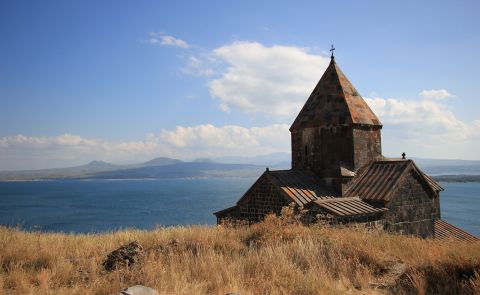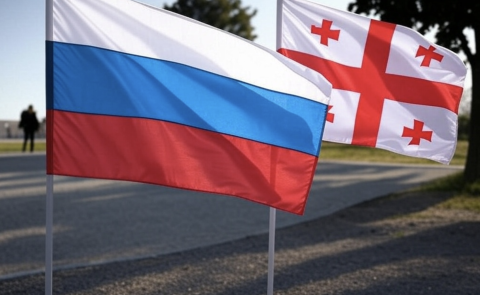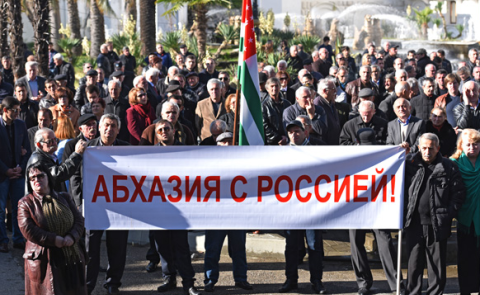
Russia and the Eastern Partnership: Protracted Confrontation

Armenia and Russia have been gradually distancing themselves over the past six years, but Yerevan's latest moves challenge two key pillars of Russian hard security that Moscow has been investing in with all its might not only in the Caucasus but throughout the Eastern Partnership area since the programme's inception.
Unfolding tensions
Armenia and Russia are experiencing increasing mutual animosity.
Moscow has never truly accepted the transition of power from the old guard of Kocharyan and Sargsyan to Pashinyan, and much of the efforts of the Pashinyan government since the beginning of his first term, after the Velvet Revolution, were dedicated to convincing the then-primary ally that the change in leadership would not affect the country's foreign policy and geopolitical orientation. However, few years apart, this initial intent seems to have waned. During the 44-day war, there were cases of military incidents into Armenia proper that were promptly communicated by Yerevan to Moscow, without yielding the desired outcomes for the Armenian side. Then there was the post-war period, characterized by growing Armenian disillusionment with the protection offered by the Russian ally. Yerevan received no guarantee of intervention for encroachments on its territory from either Russia or the Collective Security Treaty Organization. It is worth noting that Russia and Armenia have a series of bilateral security agreements, sealed by the Treaty on Friendship, Cooperation, and Mutual Assistance of 1997, the Agreement on the Russian military base on the territory of Armenia of 1995, the interstate agreements on the creation of a Joint Regional Air Defence System of 2015, and on the joint combat duty for air defence in 2000. Russia and Armenia also signed an Agreement on a Joint Group of Forces in 2016.
The Russian military outposts in the conflict area, including the Russian-Turkish monitoring centre in Azerbaijan, the approximately 2000 peacekeepers, and the Russian border guards patrolling the country's borders, had no deterrent effect against military actions by Azerbaijan, the extra-territorial area inhabited by Armenians until 2023, and Armenia itself. This lack of operational capability or will has been accompanied by statements from various Russian diplomatic and media figures that clearly suggested Moscow would not support the demands of Pashinyan's government. Instead, they sought to attribute to the current elected representatives as much responsibility as possible for the Armenian military debacle, often referring to them as a “temporary” government, implying that a return to a government more congenial to Russia was the only unchanged aspect of the relationship between the two countries during the last five years.
In late February, the President of the Armenian Parliament, Alen Simonyan, suggested that the 2020 Azerbaijani attack may have received the green light from Moscow. It wouldn’t be the first time Russia used a war to try to remove a leadership from the post-Soviet space that it disapproves of, albeit consistently failing in its attempts. It happened with Georgia in 2008 and with Ukraine in 2014 and 2022. Saakashvili, Pashinyan, and Zelenskyy remained in power despite the heavy tolls of the wars, and the Ukrainian Revolution of Dignity continued despite the country's territorial erosion. Similarly, the courses of the Georgian Rose Revolution and the Armenian Velvet Revolution were not reversed by the war issue.
After 2023
During the pre-war period, Yerevan's hands were tied – concerning the relationship with Moscow - due to the Karabakh issue. Armenia merely restricted the entry into the country of Kremlin-aligned and openly critical of the Pashinyan government figures, and expressed discomfort over unmet expectations, blocking motions from the CSTO that didn’t meet its demands.
After September 2023, Russo-Armenian relations are in a freefall, with Yerevan progressively introducing measures that Moscow can only perceive as anti-Russian. In January, Armenian military personnel inspected a Russian convoy and arrested two soldiers for drug possession. Yerevan openly debunked Moscow's importance as the holder of the original maps necessary to define and demarcate Armenian-Azerbaijani borders. Moscow strongly protested against an act of vandalism targeting the Children of Leningrad Blockade monument in Yerevan's Vahagn Davtyan Park, while Armenia increasingly signals its desire to break away from the constant evocation of the Soviet past. In the country, there is discussion about rewriting the national anthem and the country's symbol, along with the constitution: in short, an Armenia increasingly projected towards a future different from the 20th century and the first two decades of the new century. Russian-language programs offered by Armenian public broadcasters have declined sharply, and the issue of the status of Russian as an international language, protected and preserved in former Soviet countries is a very sensitive issue for Moscow. Since 2023, Yerevan has been part of the Rome Statute, with all possible implications regarding Putin's status as an indicted individual. In March the Central Bank of Armenia banned local banks from servicing the Mir card due to the threat of secondary sanctions. In particular, since late February - early March, new disputes opened between Armenia and Russia. And they concern issues of pivotal importance to Russia.
Hard Security
The new sources of tensions are related to two aspects of hard security that are priorities for Moscow: its military presence and the non-expansion of third states or organizations considered hostile or competitors in areas that Russia considers to be of exclusive interest, such as Armenia.
Not only the fate of the Russian peacekeepers in the former Nagorno-Karabakh will be largely determined by Azerbaijani arbitrariness, but Armenia has declared its intention to dismantle the Russian presence from the Yerevan airport, Zvarnost. Moscow immediately expressed irritation at this move, which has been officially announced by Armenia.
It should be clarified that Russian border guards have peculiarities compared to those of Western countries, that usually put them under the Ministry of Internal Affairs. Since 2003, Russian border guards have been part of the FSB, the successor to the KGB, a military body that is not under the control of the Ministry of the Interior or the Ministry of Defence, as was the case with the KGB. The FSB has intelligence tasks and capabilities and it never formally committed to refraining from exercising them beyond national borders. Therefore, the presence of Russian border guards at Zvarnost, continuous since 1992 but not regulated by a specific delegation of powers from the Armenian government, should be understood within the framework of the prerogatives and functions that Russia recognizes for the FSB and all its branches.
The second front concerns the role of third actors in the region. Pashinyan has made it clear that Armenia not only welcomes the potential accession of Georgia to the European Union but also intends to explore the possibility of advancing its own candidacy. He received encouragement in this regard in early March by the European Parliament, which, in the resolution “on closer ties between the EU and Armenia and the need for a peace agreement between Azerbaijan and Armenia”, states that if Armenia were interested in applying for candidate this could lay the groundwork for a transformative phase in EU-Armenia relations. The European Parliament invites the Commission and the Council to actively support Armenia’s desire for greater cooperation with the EU, not only in the economic partnership sector but also in political dialogue, integration, and security cooperation.
This slice of the Caucasus is thus undermining several pillars of Russian neighbourhood policy: the presence of an unresolved conflict in which Moscow can play a key role, the continuity of Russian military presence as it has taken shape so far, and the non-further enlargement of the European Union among post-Soviet countries.
The Eastern Partnership and the Russian military response
The possible enlargement of the EU was always met with military response by the Kremlin. 2008 marked the NATO Summit in Bucharest and the launch of the Eastern Partnership involving six countries beyond the European Union: Armenia, Azerbaijan, Belarus, Georgia, Moldova, and Ukraine. The six countries expressed interest in closer ties with the European Union. Three of these countries hosted Russian military bases at the time: Belarus had a radar station in Hantsavichy, a naval communication centre in Vileyka, and an air defence centre in Baranovichi, with a total of about 1,500 Russian military personnel permanently stationed in the country. In Ukraine, there was the leased naval base in Sevastopol, which should have been renewed after 2014, hosting approximately 26,000 Russian military personnel. All in all, Russian military presence on the European border was limited but evident.
In the Caucasus, the situation was different. In Georgia, the Russians had withdrawn in 2005 as a consequence of bilateral agreements. In Azerbaijan, negotiations were underway to renew the lease of the Soviet radar, which would not be successful, leading to the complete Russian withdrawal in 2012. Following the dissolution of the Soviet Union, Azerbaijan refused to host Russian military bases. The case of Armenia was different, as it had and still has a Russian base of about 5,000 military personnel in Gyumri, along with other military support sites and border guards.
In addition to these presences, there were ceasefire observers in Abkhazia, observers in South Ossetia, and about 1,500 personnel stationed in Transnistria.
Following the year of the Bucharest Summit and the Eastern Partnership, this number would likely have doubled – precise data is not disclosed by Moscow – and would have brought Russian military presence to all countries of the Eastern Partnership, including with nuclear sites. And this happened before the invasion of Ukraine, that completely changed the military landscape of the region. This military escalation on the doorstep of Europe, coupled with a 170% increase in military spending over the past two decades, accounting for over 4% of the national GDP in 2021, suggests that the Russian Federation is determined to exert military coercion to establish influence that might otherwise be difficult to impose.
The Caucasus was the first region to be progressively militarized by the Russians.
In Georgia, the absence of Russian bases lasted only three years. In August 2008, Russia intervened in South Ossetia and Abkhazia under the pretext of protecting the Russian-speaking minority subjected to an alleged genocide in South Ossetia. The ceasefire agreement stipulated a withdrawal of troops by all parties involved in the conflict to their positions prior to the war, a requirement that Georgia complied with, but Russia did not. In fact, Moscow recognized the independence of Abkhazia and South Ossetia and argued that the ceasefire agreement could not extend to the territory of new states with which Russia entered into different military agreements. As a result, there are currently about 4,500 Russian military personnel in Abkhazia and 3,500 in South Ossetia.
In Central Caucasus, there has also been a reinforcement of Russian military presence in Armenia and Azerbaijan. Following the Armenian-Azerbaijani war in 2020, 2000 Russian peacekeepers are stationed in Karabakh. Azerbaijan also hosts Russo-Turkish observation sites to monitor ceasefire compliance. Additionally, Russia has increased its presence of Russian border guards permanently stationed in Armenia and it is pushing for them to take charge of the Zangezur corridor. Armenia has already backtracked on what was agreed upon in 2020 regarding this issue.
Between 2008 and 2020, the Caucasus underwent a significant transformation in terms of the deployment of Russian forces. The military pressure is increasing in all countries within the partnership. Ukraine is undoubtedly the most explicit and dramatic case, being the only one at present where military pressure has materialized into territorial conquests and annexations. But also in all the other countries, it is clear that Russia intends to confirm its assertiveness through security control, up to the nuclear threat. The referendum in Belarus in 2022 opened the country to Russian nuclear weapons. Belarus is suspended but not definitively excluded from the Eastern partnership after the domestic developments that preceded the war in Ukraine.
The deployment of the nuclear arsenal and the annexation of territories represent a quantitative and qualitative leap compared to the post-Soviet wars seen so far.
The Russian military escalation in the countries of the Eastern Partnership does not appear to be merely a conjectural response to current conflicts, but rather a process that has been underway for the past 15 years and is likely to have the character of a permanent military presence in Moscow's plans.
Contributed by Dr. Marilisa Lorusso





